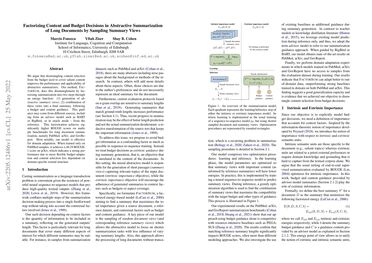Factorizing Content and Budget Decisions in Abstractive Summarization of Long Documents
We argue that disentangling content selection from the budget used to cover salient content improves the performance and applicability of abstractive summarizers. Our method, FactorSum, does this disentanglement by factorizing summarization into two steps through an energy function: (1) generation of abstractive summary views; (2) combination of these views into a final summary, following a budget and content guidance. This guidance may come from different sources, including from an advisor model such as BART or BigBird, or in oracle mode -- from the reference. This factorization achieves significantly higher ROUGE scores on multiple benchmarks for long document summarization, namely PubMed, arXiv, and GovReport. Most notably, our model is effective for domain adaptation. When trained only on PubMed samples, it achieves a 46.29 ROUGE-1 score on arXiv, which indicates a strong performance due to more flexible budget adaptation and content selection less dependent on domain-specific textual structure.
PDF Abstract








